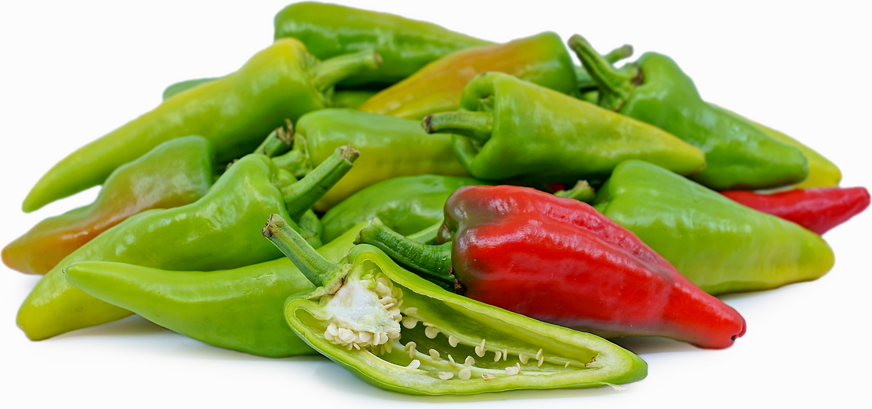


Chile De Agua Peppers
Estimated Inventory, lb : 0
Description/Taste
Chile de Agua peppers are curved to straight pods, averaging 7 to 10 centimeters in length and 2 to 3 centimeters in diameter, and have a conical shape tapering to a rounded point on the non-stem end. The skin is waxy, glossy, and smooth, ripening from pale green to yellow, orange, and then to red when mature. Underneath the skin, the flesh is semi-thick, pale green to white, crisp, and aqueous, encasing a central cavity filled with round and flat, cream-colored seeds. Chile de Agua peppers have a complex flavor consisting of herbal, fruity, sweet, and sour notes mixed with a moderate level of spice.
Seasons/Availability
Chile de Agua peppers are available year-round, with a peak season in the late summer through early fall.
Current Facts
Chile de Agua peppers, botanically classified as Capsicum annuum, are rare heirloom peppers that grow on small, bushy plants and belong to the Solanaceae or nightshade family. Primarily localized to their native region in the valley of Oaxaca in Mexico, Chile de Agua peppers grow upright, pointing towards the sky, and contain a moderate level of heat that is similar to a jalapeno. The name Chile de Agua roughly translates from Spanish to mean “water chile” or “irrigated chile,” and this name is derived from the ancient way in which the peppers were grown in seasonal rains. Chile de Agua peppers are not grown commercially but are slowly being introduced into the southwestern United States by small farms as a specialty variety and are gaining in popularity. In their native region, the peppers are slowly disappearing as local farmers are cultivating other pepper varieties such as the guajillo to increase profits.
Nutritional Value
Chile de Agua peppers are an excellent source of vitamin C, which is an antioxidant that can help promote a healthy immune system and provides potassium, vitamin A, and iron. The pepper also contains capsaicin, which is a chemical compound that triggers the brain to feel spice or heat and provides some anti-inflammatory properties.
Applications
Chile de Agua peppers are best suited for both raw and cooked applications such as frying, roasting, grilling, and baking. When fresh, the peppers can be chopped into salsas, blended into hot sauces, or diced to make a relish. The peppers can also be roasted for a developed smoky flavor and can be served over tacos or blended into mole sauces. In Oaxaca, Chile de Agua peppers are popularly used in chile rellenos and are rinsed and split lengthwise, roasted and stuffed with cheese or shredded meat, dipped in egg whites, and then fried. The chile relleno is a popular street food in Mexico and is commonly found wrapped in a tortilla with red rice, a hard-boiled egg, and black bean paste. The flavor of Chile de Agua peppers also compliments braised meats and can be diced into pork hash or dried and ground into a powder to be used as a seasoning. Chile de Agua peppers pair well with red onions, fresh cheeses, meats such as grilled chicken, pork, or beef, cilantro, epazote which is an aromatic herb use in Mexico, cucumber, avocado, and lime juice. The peppers will keep up to one week when loosely stored whole and unwashed in a plastic or paper bag in the refrigerator.
Ethnic/Cultural Info
In the semi-arid valley of Oaxaca, Chile de Agua peppers have been uniquely grown for at least three hundred years as part of the ancient "milpa" system of community farming. The word “milpa” is derived from a Nahuatl phrase that roughly translates to mean “to the field.” This ancient system of growing crops, specifically corn, beans, and squash along with companion crops such as peppers, was designed to maximize output and maintain sustainability. The process of planting many different species in one space allowed the plants to coexist and also provided mutual benefits to make the cultivation process easier. This traditional system is still used in the valley of Oaxaca today, and farmers use burros, handmade tools, wooden plows, and cattle to cultivate the land. Once the peppers are harvested, they are transported to local markets in Oaxaca where they are sold in bunches of five to six peppers displayed on a large leaf or plate.
Geography/History
Chiles de Agua have, until recently, only been grown in the valley of Oaxaca, located just north of the city of Oaxaca in southern Mexico. The peppers first gained notoriety as a crop that was developed as a part of the milpa system, and as native Oaxacans move out of the area and bring the pepper seeds with them, cultivation is slowly spreading beyond its native region. Today Chile de Agua peppers are found in limited quantities outside of Oaxaca and are commonly grown in home gardens as a specialty variety or sold through small farms in Mexico and the United States.
Recipe Ideas
Recipes that include Chile De Agua Peppers. One
| Thoughts from the Grill |
|
Chile de Agua Salsa |




